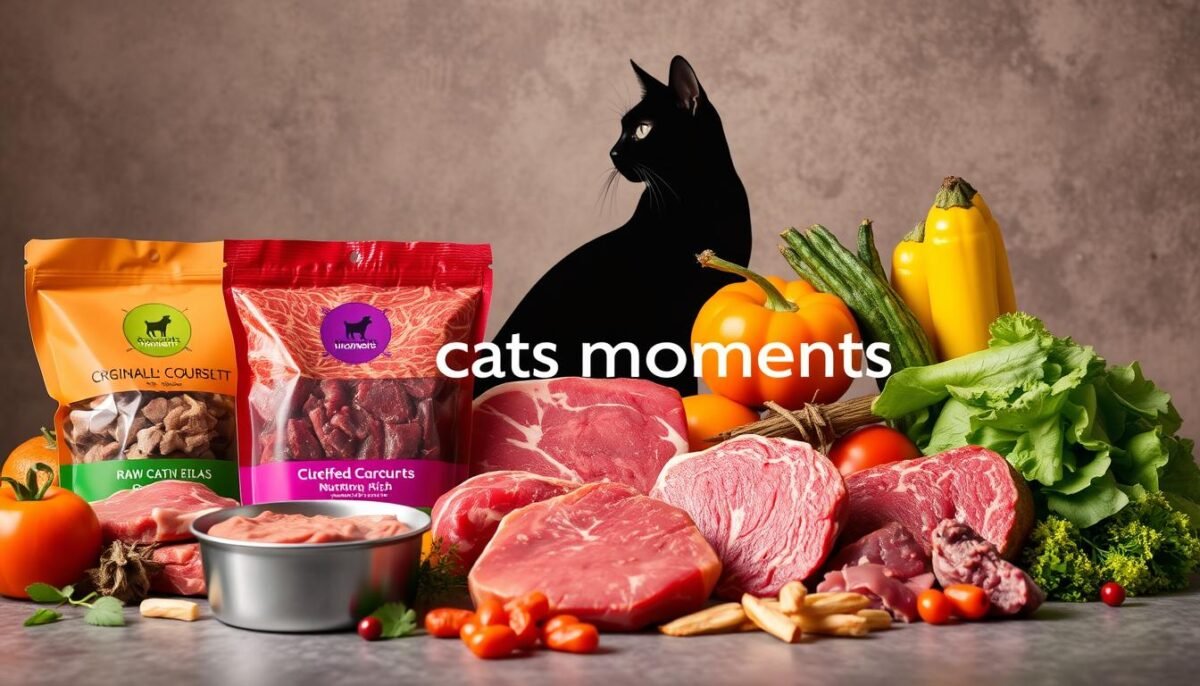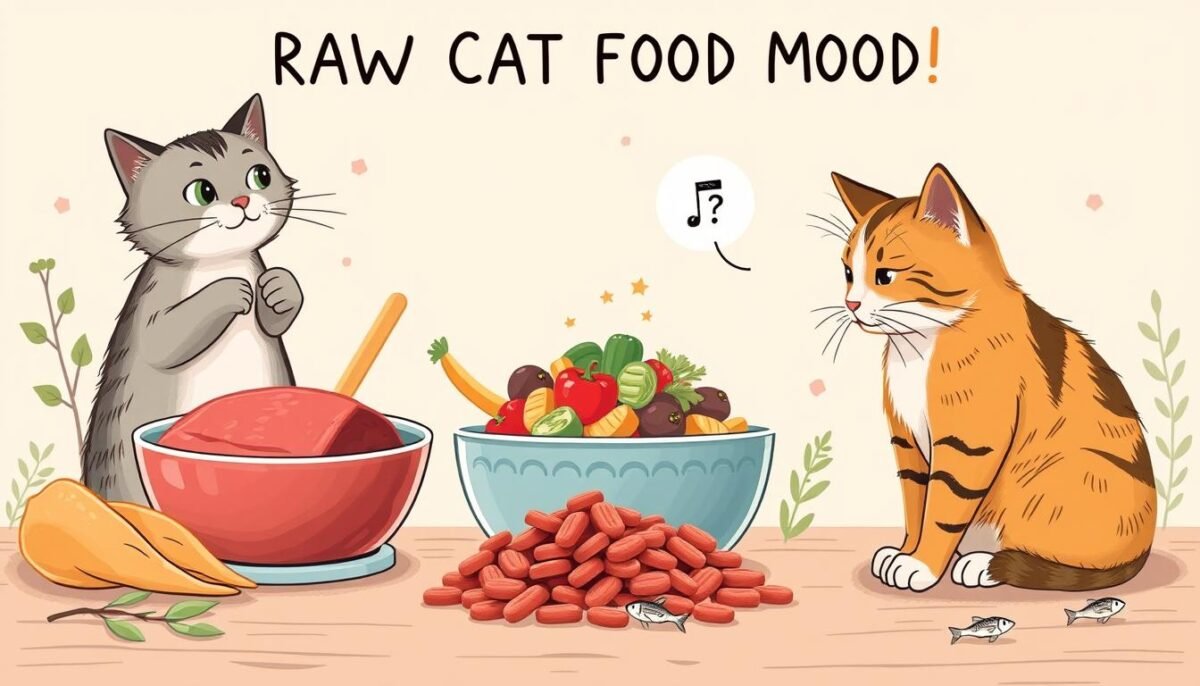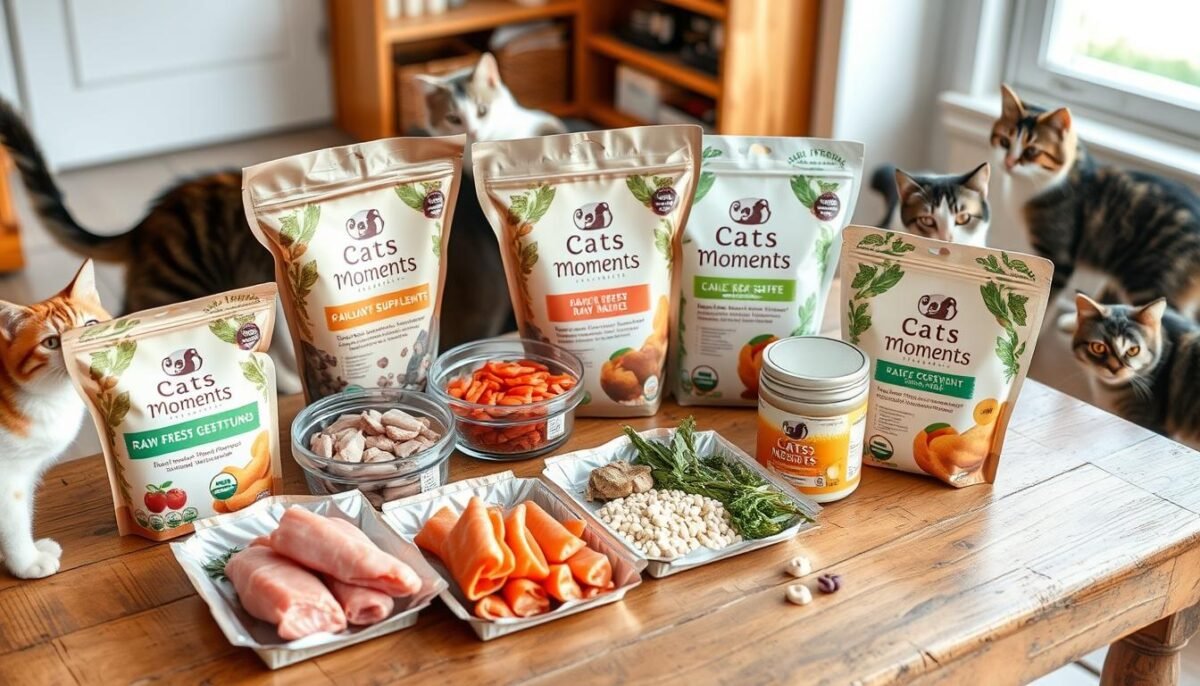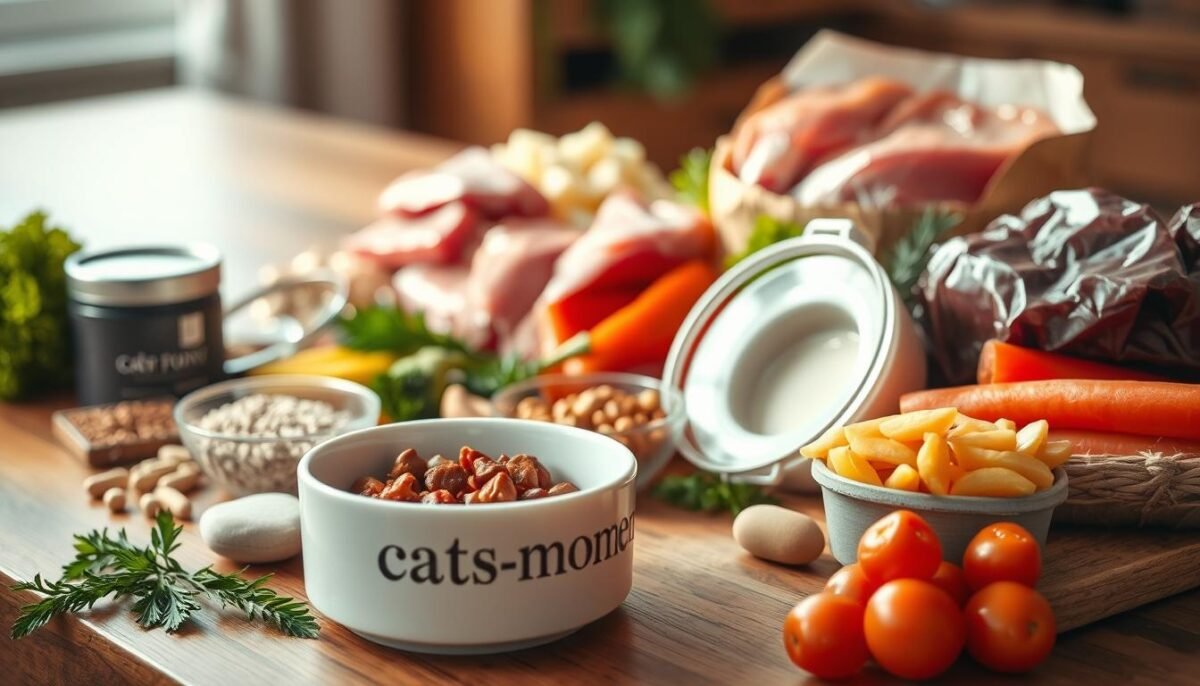As pet owners, we all want the best for our cats. Have you thought about a raw food diet for your cat? This guide will cover the benefits, risks, and safe ways to add raw food to your cat’s diet.
Finding the right food for your cat can be hard. But with the right info, you can choose what’s best for them. We’ll explore raw feeding, debunking myths and helping you understand natural cat nutrition.
Key Takeaways
- Discover the benefits of raw cat food, including improved health, digestion, and coat condition.
- Learn how to safely transition your cat to a raw diet and monitor their response.
- Understand the essential nutrients found in raw cat food and how they support your feline’s well-being.
- Explore the differences between commercial and homemade raw diets, and how to select the right option.
- Gain insights into the proper handling and preparation of raw cat food to ensure your pet’s safety.
Ready to give your cat a more natural diet? Let’s explore raw cat food together!
Understanding Raw Cat Food
We all want the best for our cats, and that includes their diet. Raw cat food is a natural choice that matches their ancestral eating habits. It’s a unique way to feed our pets, and knowing its benefits and challenges is key.
What is Raw Cat Food?
Raw cat food is made from uncooked, simple ingredients like meat, organs, and bones. It’s like what cats would eat in the wild. This diet is different from kibble or canned food, as it’s more natural for cats.
Types of Raw Cat Food
- Commercially Prepared Raw Diets: These are ready-to-eat, frozen, or freeze-dried foods made for cats.
- Homemade Raw Recipes: Owners can make their own raw cat food using fresh ingredients and recipes.
Both types have their own benefits and things to think about. Owners need to decide what’s best for their cats.
| Commercially Prepared Raw Diets | Homemade Raw Recipes |
|---|---|
| Convenience and consistency | Customization and control over ingredients |
| Nutritional balance and formulation | Potential for cost savings |
| Strict safety protocols and quality control | Requires more time and effort in preparation |
As pet owners, we can choose between commercial and homemade raw cat food. Understanding raw cat food helps us make the best choice for our cats. This way, we ensure they get the nutrition they need.
The Benefits of Feeding Raw
We all want the best for our cats. That’s why many are turning to natural cat nutrition and feline diet through raw feeding. This approach is gaining popularity and offers many health benefits for our pets.
Health Improvements in Cats
Switching to raw food can greatly improve a cat’s health. Owners often notice better energy, coat, and dental health. The raw diet gives cats the nutrients they need without harmful additives.
Enhanced Digestive Health
A raw feline diet is great for a cat’s digestive system. It includes natural enzymes and probiotics. These help with better nutrient absorption and reduce digestive problems like vomiting or diarrhea.
Better Skin and Coat Condition
Cats on a raw diet often have better skin and coat. The diet’s high-quality natural cat nutrition includes essential fatty acids. This nourishes the skin and makes the coat shiny and healthy. Many owners also see less shedding and fewer skin irritations.
| Benefit | Description |
|---|---|
| Improved Energy Levels | Cats fed a raw diet often exhibit increased energy and vitality, as the natural nutrients in the food provide them with the fuel they need to thrive. |
| Healthier Skin and Coat | The essential fatty acids and other nutrients in raw food nourish a cat’s skin and promote a shiny, healthy coat, often reducing shedding and skin irritations. |
| Better Dental Health | The chewing and tearing required to consume raw, meaty bones can help to reduce plaque and tartar buildup, leading to improved dental health. |
“Switching our cat to a raw diet has been a game-changer. We’ve seen such a dramatic improvement in her energy, coat, and overall well-being. It’s truly amazing the difference a natural cat nutrition can make.”
More and more research supports the benefits of a raw feline diet. It improves digestive health and makes the coat shiny and healthy. By choosing raw feeding, we can help our cats live better lives.
Potential Risks of Raw Feeding
Raw cat food has many benefits, but it also comes with risks. As pet owners, we need to think about the nutritional balance and safety when switching to a raw diet for our cats.
Balancing Nutritional Needs
One big worry with raw feeding is making sure our cats get all the nutrients they need. Raw cat food can have different amounts of nutrients. If the diet is not balanced, it can harm our cats’ health. We must choose raw foods that give our cats everything they need to stay healthy.
Bacterial Contamination Concerns
Another risk of raw cat food is the chance of getting sick from bacteria like Salmonella or Listeria. These germs can hurt our cats and us. To keep our cats and families safe, we need to handle, store, and prepare raw food carefully. Following food safety rules can help lower the risk of getting sick.
| Potential Risks | Mitigation Strategies |
|---|---|
| Nutritional Imbalances |
|
| Bacterial Contamination |
|
By taking steps to address these risks and following good practices, we can safely add raw food to our cats’ diets. The health and happiness of our cats are our main concern. With careful raw feeding, we can help them live long, healthy lives.
How to Transition to Raw Cat Food
Switching your cat to raw food can be easy and rewarding. But, it needs careful planning. We’ll show you how to make the change smoothly, focusing on your cat’s health.
Gradual Introduction Steps
It’s important to introduce raw cat food slowly. Sudden changes can upset your cat’s stomach and make them not like the new food. So, we suggest a gradual change over 7-10 days:
- Begin by adding a small amount of raw food (about 10-20%) to their usual diet.
- Slowly increase the raw food while decreasing the old diet over the next days.
- By the end, your cat should be fully used to the raw food.
Monitoring Your Cat’s Response
Keep a close eye on your cat during the raw cat food transition. Look for signs they’re adjusting well, like:
- More energy and activity
- Better skin and coat
- Less shedding
- Smaller, firmer stools
- More interest in food
If your cat shows signs of not adjusting well, like vomiting or not wanting to eat, slow down the feline diet change. Or, talk to your vet for advice.
By following these steps and watching your cat closely, you can make a smooth transition to raw food. This will help keep your cat healthy and happy.
Essential Nutrients in Raw Cat Food
As pet owners, it’s vital to give our cats a balanced diet. Raw cat food is packed with nutrients that keep our feline friends healthy. Let’s explore the key nutrients in raw diets that meet our cats’ special needs.
Proteins and Fats
Proteins and fats are the base of a raw diet. Cats need a lot of animal proteins to stay healthy. Raw cat food offers high-quality proteins like muscle meat and bones, just like their natural prey.
These proteins help with growth, repair, and maintenance. Raw diets also have healthy fats like omega-3 and omega-6. These fats are good for the skin, coat, and immune system.
Vitamins and Minerals
Raw cat food is full of vitamins and minerals too. These include vitamins A, B-complex, C, D, and E, and minerals like calcium and iron. They help with bone health, immune function, and energy.
Feeding raw pet food meets your cat’s natural dietary needs. It can boost their health, energy, and coat shine. This makes them happier and healthier.
| Nutrient | Importance in Feline Diets |
|---|---|
| Proteins | Essential for tissue growth, repair, and maintenance. |
| Fats | Support skin and coat health, immune function, and overall wellbeing. |
| Vitamins | Promote bone and teeth development, immune system function, and energy metabolism. |
| Minerals | Contribute to various bodily functions and overall health. |
Selecting the Right Raw Cat Food
Choosing the right raw cat food can be tough. There are many options, from commercial diets to homemade recipes. With the right help, you can find the best raw food for your cat’s needs.
Commercial vs. Homemade Raw Diets
Commercial raw cat food is easy and balanced. It’s made to give your cat all the nutrients they need. Homemade diets let you pick the ingredients and tailor the food to your cat’s taste.
Reading Labels and Ingredients
It’s key to check the labels, whether you pick commercial or homemade food. Look for real, whole foods like meat, organs, and bones. Make sure there are no fillers or artificial stuff.
| Commercial Raw Cat Food | Homemade Raw Cat Food |
|---|---|
| Convenient and pre-formulated | Customizable to your cat’s needs |
| Carefully balanced nutrition | More control over ingredients |
| Consistent quality and safety | Requires more preparation time |
When picking raw cat food options, think about your cat’s needs and your lifestyle. With some research and careful choice, you can give your cat the best diet.

Preparing Homemade Raw Cat Food
Preparing homemade raw cat food is rewarding and cost-effective. It’s important to handle it safely for your cat’s health. Let’s look at how to make tasty, balanced meals for your pet.
Safe Handling Practices
When making homemade raw cat food, cleanliness is key. Always wash your hands with soap and water before and after handling raw ingredients. Make sure all utensils, surfaces, and containers are clean and sanitized to avoid bacterial contamination.
Keep raw ingredients in the fridge or freezer. Thaw them in the fridge, not at room temperature. Keep raw meat separate from other foods to avoid cross-contamination. Throw away any leftovers or unused portions to keep the food fresh and safe.
Recipe Ideas for Raw Cat Meals
Making a balanced homemade raw cat food recipe is fun and creative. Use lean proteins like chicken, turkey, or fish. Add organ meats like liver and heart for extra nutrients. Include ground bone or eggshells for calcium.
Vegetables like spinach, carrots, or pumpkin add fiber and vitamins. Healthy fats from fish oil or coconut oil are also good. Adjust the amounts and mix different ingredients to meet your cat’s nutritional needs. Talk to your vet or a pet nutritionist for the best recipe for your cat.
By following safe handling practices and making tasty homemade raw cat food, you can give your cat the natural nutrition they need. Start this rewarding journey and see your cat flourish!
Addressing Common Misconceptions
There are many myths and misconceptions about raw cat food. It’s key to clear up these myths with facts. This helps cat owners make better choices for their pets’ diets.
Myths About Raw Feeding
- Raw food is unsafe and can make cats sick: This is a common misconception. With proper handling and high-quality ingredients, raw cat food can be safe and healthy.
- Raw feeding is too expensive: While it may cost more upfront, the health benefits can save money in the long run. This includes fewer vet bills and a healthier cat.
- Cats need dry kibble for dental health: This is not true. Raw meats and bones can actually help keep cats’ teeth and gums healthy.
Clarifying the Misunderstood
Many cat owners are worried about the safety and nutrition of raw feeding. But, with help from vets and trusted raw food providers, these worries can be eased. Raw cat food, when made right, can give cats all they need for health and happiness.
“Raw feeding is a natural and biologically appropriate way to nourish our feline companions. By addressing common myths and misconceptions, we can empower cat owners to make informed choices about their pets’ diets.”

The raw feeding movement is growing, and it’s important to share the truth. We need to give cat owners the right info about raw food’s benefits and what to consider. By debunking these myths, we help pet owners make choices that keep their cats healthy and happy.
Frequently Asked Questions
Pet owners often have questions about raw cat food. We’ll cover some common concerns. This will help you decide if raw feeding is right for your cat.
Is Raw Feeding Suitable for All Cats?
Raw feeding is good for many cats but not all. Age, health, and personal taste matter. Kittens, older cats, and those with health issues might need special diets.
Always talk to your vet. They can help pick the right raw food for your cat’s needs.
How to Store Raw Cat Food Properly
Storing right is key. It keeps it fresh and safe. Here’s how to do it:
- Freeze raw food until you’re ready to use it. Then, thaw it in the fridge, not at room temperature.
- Use airtight containers or resealable bags to store frozen food. This stops cross-contamination.
- Don’t let raw food sit out for more than two hours. Bacteria can grow fast.
- Throw away any leftover raw food that’s been out too long or past its use-by date.
- Keep your freezer clean and organized. This helps keep your cat’s food safe and fresh.
By following these steps, you can keep your cat’s raw meals safe and nutritious.
| Storage Method | Shelf Life |
|---|---|
| Frozen | 3-6 months |
| Refrigerated (Thawed) | 3-5 days |
Good storage habits are crucial. They keep your cat’s raw food safe and healthy.
Finding Reliable Suppliers of Raw Cat Food
Getting high-quality is key to your cat’s health. You can look for suppliers locally or online. Knowing what to look for in a supplier is important to get the best for your cat.
Local vs. Online Options
Local suppliers offer a personal touch. You can see where the food is made and talk to the people who make it. Online suppliers, however, have more choices, better prices, and can deliver right to your door.
What to Look for in a Supplier
- Transparency in ingredients and sourcing practices
- Adherence to food safety standards and proper handling protocols
- Positive customer reviews and reputation within the raw feeding community
- Variety of raw food options, including complete and balanced formulas
- Reasonable pricing and affordable shipping costs
- Reliable customer service and timely delivery
When looking for raw cat food suppliers, consider both local and online options. This way, you can make sure your cat gets the best natural pet food sources. Taking the time to find the right supplier can greatly improve your cat’s health.

“Providing your cat with the best possible raw food is essential for their optimal health and well-being.”
Conclusion: The Future of Raw Feeding
As we start to give our cats the best diet, the future of raw feeding looks bright. More people are seeing the benefits of raw cat food. This is thanks to new pet food technology.
A Sustainable Choice for Our Cats
The raw cat food trend shows a move towards better nutrition for cats. This trend matches the growing need for natural pet food. As cat owners learn more about raw feeding, we expect more cats to enjoy its benefits.
Encouraging Community Sharing and Learning
To make raw feeding better, we need a supportive community. Cat owners should share their knowledge and experiences. This way, we can help each other make the best choices for our cats.
FAQ
Is Raw Feeding Suitable for All Cats?
Raw feeding is great for many cats, but it depends on your cat’s health and age. Kittens, older cats, and those with health issues might need special diets. Always talk to your vet before switching to a raw diet for your cat.
How to Store Properly?
Keeping raw cat food safe and fresh is key. Freeze it until you’re ready to use it, and thaw in the fridge, not at room temperature. Use leftovers within 3-4 months. Always follow the storage tips from the food’s maker to keep it safe and tasty for your cat.
How to Transition to Raw Cat Food?
Switching to raw food should be slow to let your cat’s stomach adjust. Start by mixing a bit of raw food with their old diet. Gradually increase the raw food over weeks. Watch your cat closely and adjust the pace if needed. Getting help from a vet or nutritionist can make the transition smoother.
What are the Potential Risks of Raw Feeding?
Raw feeding has many benefits but also some risks. It can be unbalanced or contaminated if not done right. Always work with a vet or nutritionist to ensure your cat gets the right nutrients. Also, follow safe handling practices to avoid foodborne illnesses.
Where Can I Find Reliable Suppliers of Raw Cat Food?
You can find from local pet stores, online, or specialty shops. Look for suppliers that focus on safety, clear labeling, and quality ingredients. Talking to other cat owners can also help you find trustworthy suppliers.






